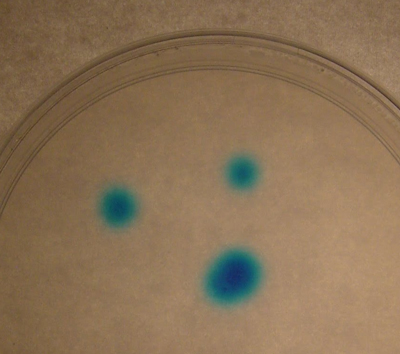|
Diffusion should be distinguished from other dispersive processes resulting from bulk transport of particles by the fluid medium itself. For example, the initial swirling of dye dropped into a glass of water is not a manifestion of diffusion, but is primarily due to gravitational forces plus thermally and mechanically induced convection currents. Only in later stages when the dye has become more uniformly distributed and the initial currents have subsided does diffusion become dominant. A better experiment demonstrating pure diffusion is to place the dye on an agar plate (where no convection currents exist). Here the dye droplets are seen to diffuse out symmetrically with time, gradually enlarging and fading in color.
|
|
In the mid-19th Century German physicist Adolf Fick modeled diffusion as the movement of particles from a region of higher concentration to a region of lower concentration. Fick showed that flux of particles was directly proportional to the concentration gradient, related by the factor D, the diffusion coefficient. Because D reflects the flux of particles through a surface during a certain period of time, it therefore has units of area/time (e.g. mm²/sec).
|
It was not until 1905 that Albert Einstein developed a comprehensive mathematical theory to explain Brownian motion and incorporate Fick's laws of diffusion. (This was part of Einstein's PhD thesis!) His original approach was to model the process as a statistical "random walk" with a Gaussian (normal) distribution. Einstein showed that in one dimension the root mean squared displacement (rrms) of a particle from its origin over a period of time (t) was proportional to . This important result thus connected Fick's diffusion coefficient (D) with the statistics of Brownian motion.
|
Einstein also incorporated into his random walk theory a principle of fluidic friction developed in the 19th Century by George Stokes. This became known as the Stokes-Einstein equation, showing that the diffusion coefficient (D) is directly proportional to the the absolute temperature (T) and Boltzmann constant (k), but inversely proportional to the radii of the particles (r) and the viscosity of the medium (η): |
The diffusion constant for pure water at body temperatures is approximately 3.0 x 10-3 mm2/sec. The values of D for biological tissues are only 10-50% as long, perhaps 1.0 x 10-3 mm2/sec on the average. According to the random walk model, this means that during the ~50 ms time frame of a diffusion-weighted imaging sequence, about 2/3 of tissue water molecules will remain within 10 µm of their origin.
|
In general, extracellular water diffuses somewhat more freely than intracellular water, as the latter has more chances to collide with cell walls, organelles, macromolecules, and the like. Water molecules can exchange between the two compartments, both passively (through membrane pores) or by active transport (aquaporin channels). Many tissues contain highly asymmetric structures, such nerve or muscle fiber bundles. This creates diffusion anisotropy, the preferential diffusion of water molecules in certain directions more than others.
|
Marked reduction in tissue diffusion occurs much less commonly than diffusion prolongation, but when it occurs it can have a dramatic effect on the diffusion-weighted MR images, rendering the abnormal areas "light-bulb bright". Diseases where this may occur include acute ischemia, infections, abscesses, toxic-metabolic insults, and with highly cellular tumors. (These disorders are discussed more completely in a later Q&A).
Advanced Discussion (show/hide)»
According to widely held definitions, the term "convection" used above consists of two components: advection and diffusion. So indeed the blue dye in the glass pictured above does have a little bit of diffusion going on within it, but the primary physical process being illustrated is "advection". Advection refers to the bulk transport of material by the medium itself independent of diffusive processes.
Brown R. XXVII. A brief account of microscopical observations made in the months of June, July, and August, 1827 on the particles contained in the pollen of plants; and on the general existence of active molecules in organic and inorganic bodies. Philosoph Mag Ann Philosophy 1828; New series 4(21):1-16.
"Diffusion." Wikipedia, The Free Encyclopedia. (I love Wikipedia!)
Einstein A. Über die von der molekularkinetischen Theorie der Wärme geforderte Bewegung von in ruhenden Flüssigkeiten suspendierten Teilchen. Annalen der Physik 1905; 17:549-560. (Einstein's original diffusion theory paper, in German).
Minati L, Weglarz WP. Physical foundations, models, and methods of diffusion magnetic resonance imaging of the brain: a review. Concepts Magn Reson 2007; 30A:278-307.
Mukherjee P, Berman JI, Chung SW, et al. Diffusion tensor MR imaging and fiber tractography: theoretic underpinnings. AJNR Am J Neuroradiol 2008; 29:632-640.
What is the difference between the diffusion coefficient (D) and the "apparent" diffusion coefficient (ADC)?
What is meant by the b-value? How do I pick it?
How do you make a DW image?
Which diseases are "bright" on DW imaging and why?






